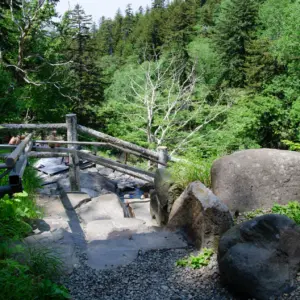Fukiage Onsen has already gained popularity on various social media platforms, but I would like to share what the experience is actually like.
Access
Fukiage Onsen is located about a 15-minute drive from the Blue Pond in Biei during the summer, and around 20 minutes in the winter. However, it is advisable to avoid driving there in winter unless you have a 4WD vehicle. Also, during bad weather in winter, it’s best not to push your limits.
In the summer, you can also access it from the direction of Ryounkaku, a well-known starting point for hiking in the Tokachidake mountain range, which is roughly a 10-minute drive. From the Blue Pond area, you will navigate a winding mountain road, while from the Ryounkaku direction, you will descend the road you came on and take a right at a T-junction marked with a sign.
In both directions, visibility may be limited due to dense foliage in summer, but you will see a large sign on the valley side of the mountain. This is Fukiage Onsen, where there is a parking lot that can accommodate about 30 cars.

After parking, you will find a narrow path on the left leading further in. From here, it’s a short walk. At the entrance to the path, there is a sign with the following precautions.
Rules for Using Fukiage Ikoi-no-Hiroba(Notice from Kami-Furano Town)
- Beware of pickpockets and car break-ins.
- Take proper care of pets (do not let them roam freely).
- Watch out for falling snow and rocks.
- The ground is slippery, so be careful.
- Camping and sleeping in cars are prohibited.
- You are responsible for your own safety in case of any accidents.
Additionally, there is a smaller sign emphasizing the following points:
- Sleeping in cars and tents is prohibited.
- Open flames are strictly forbidden.
- If these rules are not followed, the area will be closed.
Please make sure to adhere to these rules.
As you continue walking, you will soon see a river flowing below on the right, which is where the outdoor bath is located. At the entrance to the open-air bath, there is a sign detailing the history and background of the hot spring. There are also guidelines for use, listed below:

Guidelines for Using the Hot Spring
1. The pathways and the area inside and outside the open-air bath are slippery, so please be cautious.
2. This area is within a national park. Be sure to take your trash with you.
3. Do not use soap or shampoo.
4. Read the hot spring analysis sheet, and if you have any skin abnormalities, refrain from bathing.
5. You are responsible for your own safety in case of any accidents, theft, or other troubles in the parking lot, pathways, or hot spring area.
6. The bath is available for use by both men and women. Please use towels or wear swimwear and maintain proper etiquette.
7. Except for guide dogs and hearing dogs, pets are not allowed near the bath.
This outdoor bath in the midst of nature is incredibly pleasant. Be sure to follow the rules and enjoy your time!
History
Around 1897 (Meiji 30), a hot spring was discovered here, leading to the establishment of an inn by approximately 1912. Subsequently, the road leading to the hot spring was improved using private funds, and by 1928, a bus service to the hot spring was in operation. Until its closure in 1944, the area was bustling with mountain climbers, skiers, hot spring visitors, and sulfur mine workers.
Even after the buildings were dismantled in 1950, the remaining hot spring baths attracted hikers. However, it eventually fell into disuse and was forgotten.
Interest was renewed following the increase in water temperature due to the 1988 eruption of Mount Tokachi and the boom in popularity of secret hot springs and open-air baths.
In 1991, Kami-Furano Town renovated this historic open-air bath, improved the surrounding environment, and renamed it “Fukiage Open-Air Bath.”
About the Open-Air Bath
This hot spring is an open-air bath, meaning it is not enclosed indoors but is situated outside. As the term “open-air” suggests, it is a bath exposed directly to the open sky.
Japanese Bath Culture
In Japan, public baths, known as “sento,” have been common for a long time. These public baths cost around 500-600 yen to enter. Historically, sento were necessary public facilities during times when individual homes did not have bathing facilities. However, nowadays, with almost every household having its own bath, sento are becoming a vanishing aspect of Japanese bath culture in various regions.
Nevertheless, the bath culture that developed within the tradition of sento is deeply rooted in the hot spring culture across Japan. Hot springs and sento typically involve strangers sharing the same bath, with private baths being quite rare. The culture of enjoying hot springs naked with strangers is often referred to as “naked companionship.”
To those unfamiliar with Japanese customs, this concept might sound strange or awkward, but it embodies the traditional Japanese bath culture of “sharing a bath to wash off sweat and relax together, even with strangers.” It’s a very peaceful culture, don’t you think?
Therefore, before entering the bath, we thoroughly clean our bodies and refrain from placing the towels we use to wash ourselves into the bathwater. This reflects our desire to keep the bathwater as clean as possible.
Mixed Bathing
Another aspect of Japanese bath culture is mixed bathing. However, the customs of mixed bathing vary significantly across different regions of Japan. Mixed bathing literally means that men and women share the same bath without any separation. In Japan, as mentioned earlier, when many people use the same bath, they generally do so naked, regardless of gender.
Today, genuinely mixed bathing where men and women bathe naked together is quite rare. I know of a few such hot springs in Hokkaido, but in most cases, people are instructed to wear swimsuits or cover their private parts with towels. Unfortunately, some users (mostly men) insist on entering the bath naked even in mixed bathing settings, making it difficult for women to participate. It’s also a fact that some outdoor baths are monopolized by such individuals. Additionally, some groups flaunt their tattoos, which can lead to trouble, so it’s essential to be cautious.
Tattoos and the Japanese Perspective
Ordinary Japanese people generally avoid getting tattoos, as tattoos are associated with yakuza or organized crime syndicates. While it is true that some individuals wish to preserve tattooing as a Japanese cultural tradition and do not belong to these anti-social groups, they are a minority among those who have tattoos. Therefore, many sento and hot springs display signs at their entrances saying “No tattoos allowed” to refuse entry to members of anti-social organizations.
Today, tattoos as fashion are becoming more common in Japanese society. However, a full-back tattoo might still cause people to perceive the wearer as someone outside the norm.
With the increasing number of foreign tourists, some hot spring inns have stopped displaying “No tattoos allowed” signs, recognizing that tattoos on foreigners do not carry the same connotations as those in Japanese culture. We understand that these tourists are not part of anti-social groups. Nevertheless, it’s also true that such appearances can be quite intimidating to others.








